New Zealand | |
| Value | 0.01 New Zealand dollars |
|---|---|
| Mass | 2.07 g |
| Diameter | 17.53 mm |
| Edge | Plain |
| Composition | bronze |
| Years of minting | 1967-1987 |
| Catalog number | - |
| Obverse | |
| Design | Elizabeth II, Queen of New Zealand |
| Designer | Raphael Maklouf |
| Design date | 1986 |
| Reverse | |
| Design | A fern leaf around the number 1 |
| Designer | Reginald George James Berry |
| Design date | 1967 |
The New Zealand one-cent coin (minted 1967-1987, demonetised 1990), was the smallest denomination coin of the New Zealand dollar from the currency's introduction in 1967 to its demonetisation, along with the two-cent coin, on 30 April 1990. [1] With a diameter of 17.53 millimetres, it is the smallest coin ever issued of the dollar, and at 2.07 grams in mass the lightest as well. Its reverse featured a fern leaf, a sign of New Zealand. The image was designed by Reginald George James Berry, who designed the reverses for all coins introduced that year.
Coins of the New Zealand dollar were introduced on 10 July 1967 to replace the pre-decimal New Zealand pound. The dollar was pegged at two to a pound, thus 200 cents to the pound. New Zealand's one-penny coin was 1/240 of a pound. [1] The original obverse was Arnold Machin's portrait of Queen Elizabeth II, and was used until 1985. [2]
In 1986 the portrait was changed to the version by Raphael Maklouf, [3] introduced to the coins of the pound sterling in 1985. In 1988, the bronze one and two-cent coins had become too expensive to produce as inflation lowered the value of the dollar and their minting ceased. They remained legal tender until 30 April 1990.
According to the Reserve Bank of New Zealand [4] no one-cent coins were issued in 1968 or 1969 due to the large amount issued on their introduction in 1967, or in 1977. In years with no regular mintings, coins were still issued in mint sets.
Counting proofs and coins in mint sets, a total of 553,466,065 (553 million) coins of the denomination were minted during its existence. [5]

The New Zealand dollar is the official currency and legal tender of New Zealand, the Cook Islands, Niue, the Ross Dependency, Tokelau, and a British territory, the Pitcairn Islands. Within New Zealand, it is almost always abbreviated with the dollar sign ($). The abbreviations "$NZ" or "NZ$" are used when necessary to distinguish it from other dollar-denominated currencies.

Legal tender is a form of money that courts of law are required to recognize as satisfactory payment for any monetary debt. Each jurisdiction determines what is legal tender, but essentially it is anything which when offered ("tendered") in payment of a debt extinguishes the debt. There is no obligation on the creditor to accept the tendered payment, but the act of tendering the payment in legal tender discharges the debt.

The Fijian dollar has been the currency of Fiji since 1969 and was also the currency between 1867 and 1873. It is normally abbreviated with the dollar sign $, or alternatively FJ$ to distinguish it from other dollar-denominated currencies. It is divided into 100 cents.
The Jamaican dollar has been the currency of Jamaica since 1969. It is often abbreviated to J$, the J serving to distinguish it from other dollar-denominated currencies. It is divided into 100 cents, although cent denominations are no longer in use as of 2018. Goods and services may still be priced in cents, but cash transactions are now rounded to the nearest dollar.

The Solomon Islands dollar is the currency of Solomon Islands since 1977. Its symbol is $, with SI$ used to differentiate it from other currencies also using the dollar sign. It is subdivided into 100 cents.
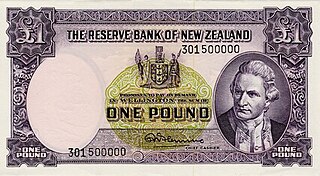
The pound was the currency of New Zealand from 1933 until 1967, when it was replaced by the New Zealand dollar. Prior to this, New Zealand used the pound sterling since the Treaty of Waitangi in 1840. Like the pound sterling, it was subdivided into 20 shillings each of 12 pence.
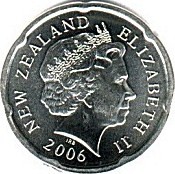
The New Zealand twenty-cent coin is the second-lowest-denomination coin of the New Zealand dollar. The 20-cent coin was introduced when the New Zealand dollar was introduced on 10 July 1967, replacing the New Zealand florin coin. Its original reverse of a kiwi was changed in 1990 when the image was moved onto the one-dollar coin. In 2006 its size was reduced and its edge altered to a Spanish flower as part of a revision of New Zealand's coins, which also saw its alloy become nickel-plated steel instead of cupro-nickel.
The coins of the New Zealand dollar are used for the smallest physical currency available in New Zealand. The current denominations are ten cents, twenty cents, fifty cents, one dollar and two dollars. The $1 and $2 coins are minted in a gold colour, the 20c and 50c coins are silver colour and the 10c coin is plated in copper.
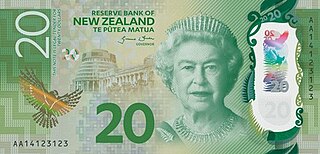
The New Zealand twenty-dollar note is a New Zealand banknote. It is issued by the Reserve Bank of New Zealand and since 1999 has been a polymer banknote. It was first issued on 10 July 1967 when New Zealand decimalised its currency, changing from the New Zealand pound to the New Zealand dollar. It has an image of Queen Elizabeth II on the front.
New Zealand dollar banknotes are the banknotes in circulation in New Zealand, the Cook Islands, Tokelau, Niue and the Pitcairn Islands, denominated in the New Zealand dollar. They are issued by the Reserve Bank of New Zealand and since 1999 have been made of polymer.
The New Zealand two-dollar coin is the largest-denomination coin of the New Zealand dollar. It was introduced along with the one-dollar coin in 1990. Both are made from an alloy of aluminium and brass. It is the largest and heaviest coin in circulation, weighing ten grams and measuring 26.5 millimetres in diameter. Its thickness is 2.7 mm, only 0.4 mm thinner than the one-dollar coin, thus it is the second-thickest coin in the country's circulation. Both the $1 and $2 coins are gold-coloured, and requests for a Koha, donation or entry fee sometimes say gold coin please.
The New Zealand fifty-cent coin is a coin of the New Zealand dollar. It was the largest by denomination, diameter and mass to have been introduced on the decimalisation of the currency on 10 July 1967, replacing the pre-decimal crown coin. A total of 81,585,200 pre-2006 50 cent coins were issued, with a total value of $40,792,600.00

The New Zealand five-dollar note is a New Zealand banknote. It is issued by the Reserve Bank of New Zealand and since 1999 has been a polymer banknote. It was first issued on 10 July 1967 when New Zealand decimalised its currency, changing from the New Zealand pound to the New Zealand dollar. The note originally had an image of Queen Elizabeth II on the front; since 1992 it has had an image of Sir Edmund Hillary. The new design released in October 2015 was named "Banknote of the Year" by the International Bank Note Society for 2015.

The New Zealand ten-dollar note is a New Zealand banknote. It is issued by the Reserve Bank of New Zealand and since 1999 has been a polymer banknote. It was first issued on 10 July 1967 when New Zealand decimalised its currency, changing from the New Zealand pound to the New Zealand dollar. The ten-dollar note originally had an image of Queen Elizabeth II on the front; since 1993 it has had an image of suffragist Kate Sheppard.
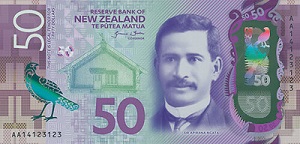
The New Zealand fifty-dollar note is a New Zealand banknote. It is issued by the Reserve Bank of New Zealand and since 1999 has been a polymer banknote. It was first issued in 1983. The note originally had an image of Queen Elizabeth II on the front; since 1992 it has had an image of Sir Āpirana Ngata.

The New Zealand one-hundred-dollar note is a New Zealand banknote. It is issued by the Reserve Bank of New Zealand and since 1999 has been a polymer banknote. It was first issued on 10 July 1967 when New Zealand decimalised its currency, changing from the New Zealand pound to the New Zealand dollar. The note originally had an image of Queen Elizabeth II on the front; since 1992 it has had an image of Ernest Rutherford.
The New Zealand ten-cent coin is the lowest-denomination coin of the New Zealand dollar. The 10-cent coin was introduced when the New Zealand dollar was introduced on 10 July 1967, replacing the New Zealand shilling coin. In 2006 its size was reduced as part of a revision of New Zealand's coins, which also saw its alloy become copper-plated steel.
The New Zealand five-cent coin was the lowest denomination coin of the New Zealand dollar from 1990 to 2006. The five-cent coin was introduced when the New Zealand dollar was introduced on 10 July 1967, replacing the New Zealand sixpence coin. On 31 July 2006 it was eliminated as part of a revision of New Zealand's coins, and it was demonetised as of 1 November 2006.
The New Zealand two-cent coin was the second smallest denomination coin of the New Zealand dollar from the currency's introduction in 1967 to its demonetisation, along with the one-cent coin, on 30 April 1990. Its reverse featured two kōwhai flowers, considered emblematic of New Zealand. The image was designed by Reginald George James Berry, who designed the reverses for all coins introduced that year.
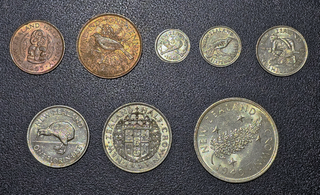
The first coinage of the New Zealand pound was introduced in 1933 in response to large-scale smuggling of prior British imperial coinage after devaluation of New Zealand exchange rates relative to the pound sterling and large influxes of other foreign coinage into circulation. The Coinage Act, 1933 outlined the weights and compositions of various denominations, out of which five silver issues entered circulation over the following year, after lengthy disagreement between rival coinage design committees. The copper penny and halfpenny entered circulation in 1940, corresponding to anniversary of the New Zealand centennial. An eighth denomination of coin, the five-shilling piece or crown, was produced solely through three commemorative issues. The first issue, the Waitangi crown, was produced in extremely limited quantities and sold to collectors. Later commemorative crown issues in 1949 and 1953 were produced for circulation.